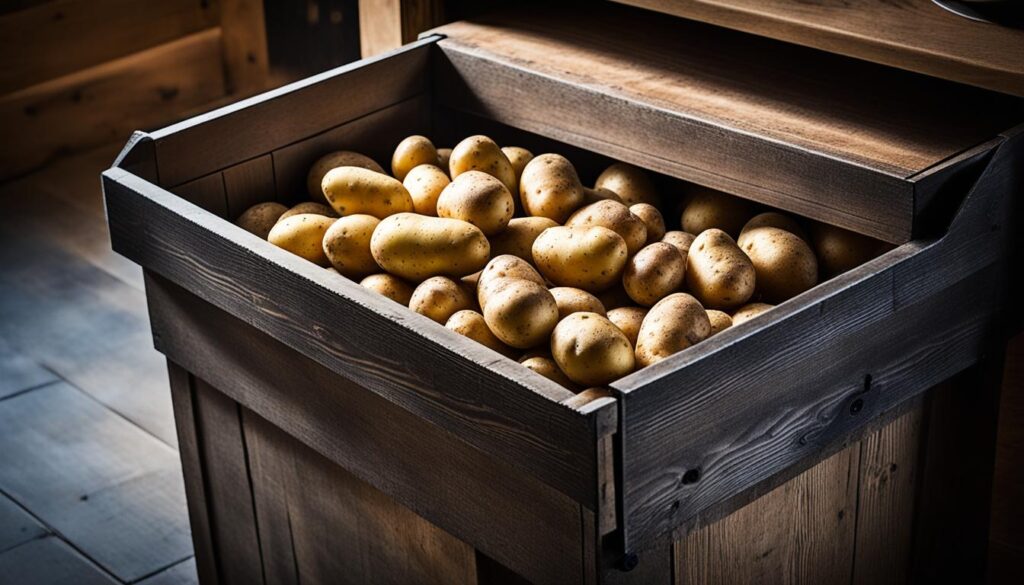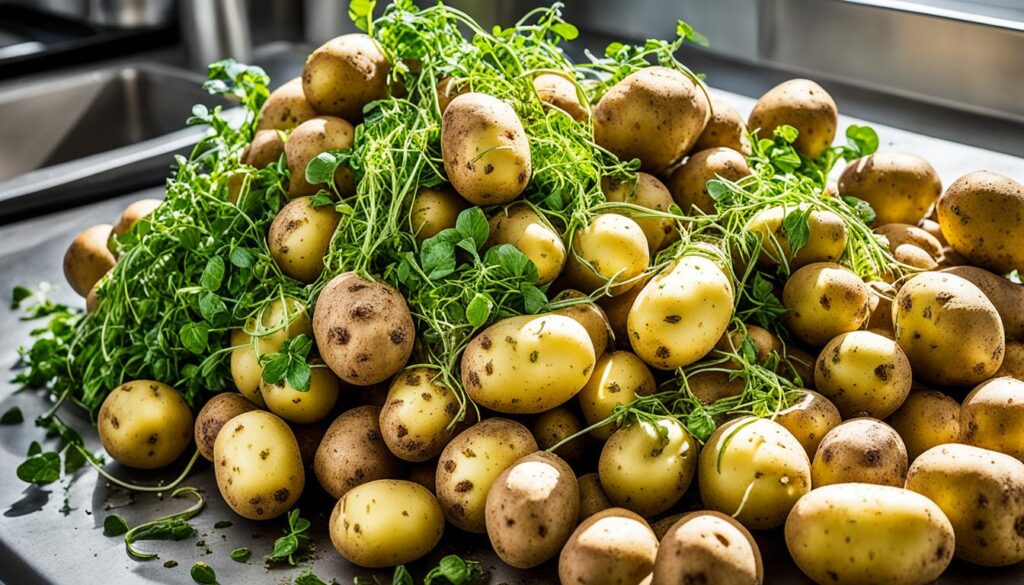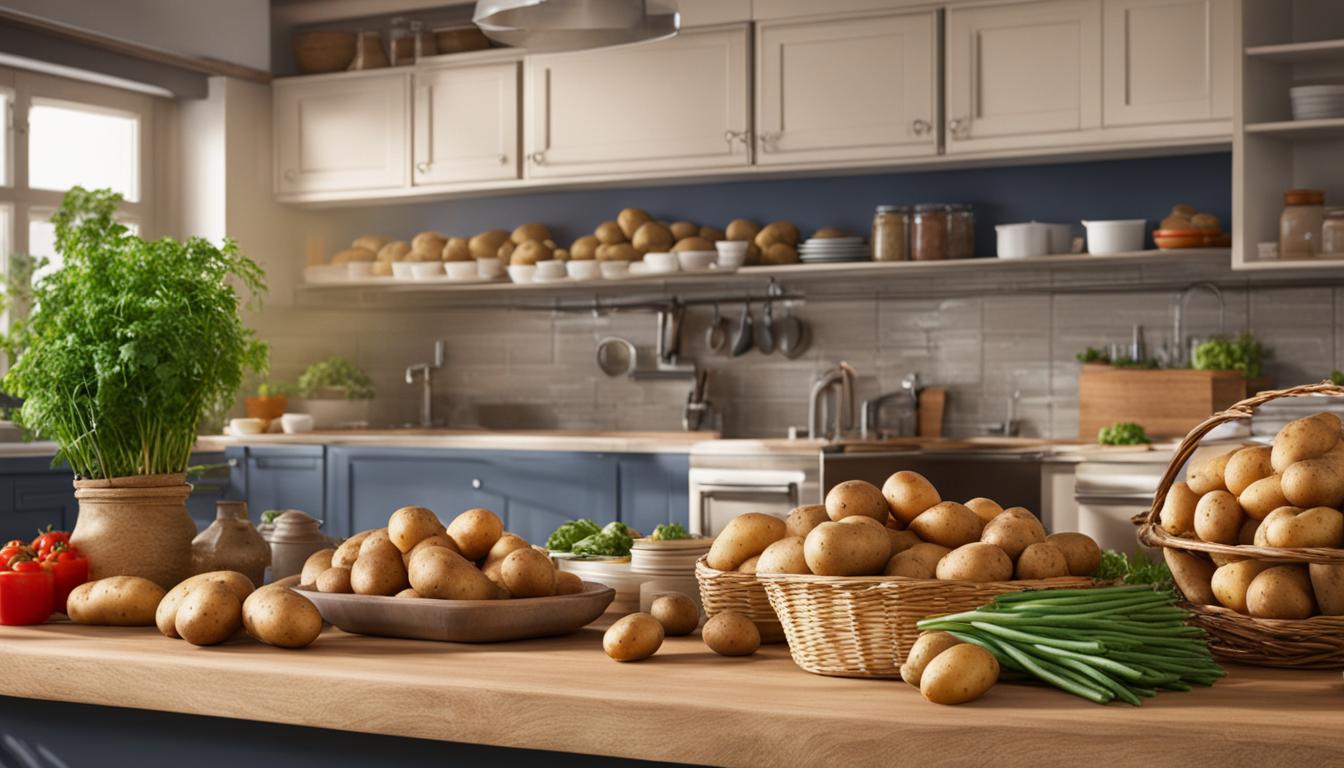Welcome to our comprehensive potato shopping and storage recipe guide. Whether you’re a seasoned chef or a novice in the kitchen, these tips will help you make the most of your potatoes. Potatoes have a rich history and are packed with essential nutrients like potassium, vitamin C, and vitamin B6. When shopping for potatoes, look for ones with tight, unwrinkled skin and avoid any signs of sprouting or rotting. In this guide, we’ll also cover the best storage techniques to keep your potatoes fresh for longer periods. Plus, we’ll share some fantastic potato recipe ideas to inspire your culinary creations. So let’s dive in and become potato experts together!
Types of Potatoes and Best Uses
When it comes to potatoes, there is a wide variety to choose from, each with its own unique characteristics and culinary applications. From fluffy mashed potatoes to crispy French fries and everything in between, different potato varieties can make a significant difference in the taste and texture of your dishes. Here are some popular potato types and their best uses.
Russet Burbank Potatoes
Best For: Light and Fluffy Mashed Potatoes, Crispy French Fries, Baked Potatoes
Russet Burbank potatoes, also known as Idaho potatoes, have a low moisture content and high starch content. This combination makes them perfect for making light and fluffy mashed potatoes that melt in your mouth. They also make deliciously crispy French fries and are the preferred choice for baked potatoes.
Yukon Gold Potatoes
Best For: Roasting, Mashing, Dishes That Require Potatoes to Retain Their Shape
Yukon Gold potatoes have a creamy texture and a balance between dry and waxy. This quality makes them versatile and suitable for a wide range of preparations. They are ideal for roasting, as they develop a golden crust while retaining a buttery interior. They also make excellent mashed potatoes and work well in dishes where the potatoes need to retain their shape.
Blue and Purple Potatoes
Best For: Roasting, Potato Salads, Mashes
Blue and purple potatoes have a medium-starchy texture and vibrant colors, which adds visual interest to your recipes. They are great for roasting, as their colors intensify and their flavors deepen. They can also be used in potato salads, providing a beautiful contrast to other ingredients. Additionally, these potatoes are suitable for mashing, producing unique and colorful mashed potato dishes.
White Potatoes
Best For: Gratins, Salads, Braises
White potatoes come in both round and long varieties, and they have a medium to low starch content. This makes them versatile and well-suited for various preparations. They work wonderfully in gratins, salads, and braised dishes, absorbing flavors and adding a creamy texture without becoming mushy.
Red Potatoes
Best For: German Potato Salad, Boiling, Roasting
Red potatoes, such as Red Bliss, have a low starch content and a thin skin. This makes them perfect for dishes that require the potatoes to hold their shape, like German potato salad. They are also great for boiling, roasting, and adding a pop of color to your recipes.
New Potatoes
Best For: Interchangeable with Red Potatoes in Recipes
New potatoes are young potatoes with thin skins. They can be used interchangeably with red potatoes in recipes, offering a similar texture and flavor. These potatoes are best enjoyed within a few days of harvest, as they have a delicate and creamy taste.
Fingerling Potatoes
Best For: Roasting, Salads
Fingerling potatoes are long and skinny, with a firm texture and unique shape. They lend themselves well to roasting, as their small size allows for quick and even cooking. They also make a visually appealing addition to salads, adding both flavor and texture.
| Potato Variety | Characteristics | Best Uses |
|---|---|---|
| Russet Burbank (Idaho) Potatoes | Low moisture, high starch | Light and fluffy mashed potatoes, crispy French fries, baked potatoes |
| Yukon Gold Potatoes | Creamy, balance between dry and waxy | Roasting, mashing, dishes that require potatoes to retain their shape |
| Blue and Purple Potatoes | Medium-starchy, vibrant colors | Roasting, potato salads, mashes |
| White Potatoes | Medium to low starch content | Gratins, salads, braises |
| Red Potatoes | Low starch content, thin skin | German potato salad, boiling, roasting |
| New Potatoes | Young with thin skin | Interchangeable with red potatoes in recipes |
| Fingerling Potatoes | Firm texture, unique shape | Roasting, salads |
With such a diverse range of potatoes available, you can experiment with different varieties and discover your favorite potato recipes. From comforting mashed potatoes to crispy roasted potatoes, the possibilities are endless when it comes to cooking with potatoes.
Proper Potato Storage Techniques
To maximize the shelf life of potatoes, follow these proper potato storage techniques:
1. Choose the Right Storage Location
Potatoes should be stored in a cool, dark, and dry place with good ventilation. The ideal temperature range for potato storage is between 45 and 55°F. This helps prevent sprouting and slows down the natural aging process of the potatoes.
2. Avoid Plastic Bags and Sealed Containers
Avoid storing potatoes in plastic bags or sealed containers as they can trap moisture, leading to mold or sprouting. Instead, opt for a paper bag, basket, or open bowl to store potatoes. These allow for air circulation and help maintain the potatoes’ freshness.
3. Keep Potatoes Dry
It is important to keep potatoes dry during storage. Avoid washing them until you’re ready to use them, as moisture can promote spoilage. Dampness can also lead to the growth of bacteria and mold, reducing the potatoes’ shelf life.
4. Avoid Refrigeration
Contrary to popular belief, potatoes should not be stored in the refrigerator. The colder temperature can cause the starch in the potatoes to convert into sugar, leading to a change in taste and texture. Instead, store potatoes in a cool, dark pantry or cellar.
5. Separate Potatoes from Fruits
Store potatoes away from fruits like onions, bananas, or apples as they release ethylene gas, which can cause potatoes to spoil faster. Ethylene gas speeds up the natural ripening process and can lead to sprouting and rotting.
| Storage Techniques | Pros | Cons |
|---|---|---|
| Paper Bag | Allows for air circulation | Can absorb excess moisture and cause drying |
| Basket | Provides good ventilation | May take up more space in storage |
| Open Bowl | Easy access to potatoes | Requires careful placement to prevent bruising |
Following these potato storage techniques will help ensure your potatoes stay fresh and prevent them from sprouting or spoiling prematurely.

How Long Do Potatoes Last and How to Determine Freshness
Potatoes are a versatile vegetable that can be stored for a long time if done correctly. When stored under the right conditions, potatoes can last for several months. In a cool, dark place with temperatures between 45 and 50°F, such as a cellar or pantry, potatoes can stay fresh and edible for up to three months. However, if stored at room temperature, they will last about two weeks before they begin to deteriorate.
To ensure that your potatoes are still fresh, it’s important to inspect them for signs of spoilage. Here are a few key indicators to look for:
- Soft spots: Fresh potatoes should feel firm and smooth to the touch. If you notice any soft or mushy areas, it may be a sign of rotting or internal damage.
- Bruising: Check for any dark or discolored areas on the skin. Bruises can indicate that the potatoes have been mishandled or are beginning to decay.
- Sprouting: Sprouts that start to emerge from the potatoes are a natural sign of aging and can indicate that the potatoes are no longer fresh.
By inspecting your potatoes regularly and being attentive to spoilage signs, you can ensure that you are using fresh potatoes in your recipes. Remember, when it comes to potatoes, freshness is key to achieving the best flavors and textures in your dishes.
Avoiding Common Mistakes in Potato Storage
When it comes to storing potatoes, there are a few common mistakes that can affect their quality and freshness. By avoiding these mistakes, you can ensure that your potatoes stay in optimal condition for longer.
- Using sealed containers or plastic bags: One of the most common mistakes is storing potatoes in sealed containers or plastic bags. While these may seem like convenient storage options, they can actually trap moisture and lead to mold or sprouting. Instead, opt for a paper bag, basket, or open container that allows for air circulation.
- Storing potatoes in the refrigerator: Another mistake to avoid is storing potatoes in the refrigerator. The colder temperature can turn the starch in potatoes into sugar, affecting their taste and texture. It’s best to store potatoes in a cool, dark, and dry place with good ventilation, such as a pantry or cellar.
- Storing potatoes near other fruits: It’s important to keep potatoes away from fruits like onions, bananas, or apples. These fruits release a gas called ethylene, which can cause the potatoes to spoil faster. Store potatoes separately from other produce to prevent premature spoilage.
Proper storage techniques are essential for maintaining the quality of your potatoes. By using a paper bag or open container, keeping the potatoes dry, and storing them in a cool, dark, and well-ventilated place, you can avoid these common mistakes and ensure that your potatoes stay fresh and delicious for longer.
“Proper storage techniques are essential for maintaining the quality of your potatoes. By using a paper bag or open container, keeping the potatoes dry, and storing them in a cool, dark, and well-ventilated place, you can avoid these common mistakes and ensure that your potatoes stay fresh and delicious for longer.”

Tips for Proper Potato Storage:
- Use a paper bag or open container: Instead of using sealed containers or plastic bags, opt for a paper bag, basket, or open container that allows for air circulation.
- Keep the potatoes dry: Avoid washing the potatoes until ready to use to prevent excess moisture, which can lead to mold or rotting.
- Store in a cool, dark, and well-ventilated place: Find a cool spot in your pantry or cellar that maintains a temperature between 45 and 55°F for optimal potato storage.
Cooking with Potatoes
Potatoes are incredibly versatile and can be cooked in a variety of ways. They can be boiled, baked, roasted, steamed, grilled, pan-fried, or sautéed. Potatoes can be the star of a dish or play a supporting role, and they can add body to soups and stews. The cooking method and potato variety will depend on the desired outcome.
Boiling potatoes are best for mashed potatoes or potato salads, while baking or roasting potatoes can result in crispy exteriors and creamy interiors. Grilling or pan-frying potatoes can create a delicious crust, and sautéing potatoes can be a quick and easy side dish. With so many cooking options, there are endless possibilities for potato recipe ideas.
Ways to Cook Potatoes:
- Boiling: Perfect for mashed potatoes and potato salads.
- Baking: Results in crispy exteriors and creamy interiors.
- Roasting: Gives potatoes a delicious crust.
- Steaming: Ideal for preserving nutrients and natural flavors.
- Grilling: Adds a smoky flavor and char to the potatoes.
- Pan-frying: Creates a crispy texture and can be seasoned with herbs or spices.
- Sautéing: Quick and easy way to enjoy potatoes as a side dish.
Potatoes can also be used to add body and richness to soups and stews. Adding diced or mashed potatoes can help thicken the broth and provide a hearty texture. Additionally, potatoes can be used in casseroles, gratins, and even desserts like sweet potato pie.
“Potatoes are like a blank canvas in the kitchen. Their texture and mild flavor make them the perfect ingredient for a wide range of culinary creations.” – Chef Emily Thompson
Experimenting with different cooking techniques and pairing potatoes with various ingredients can result in delicious and satisfying meals. Whether you’re looking for comfort food or gourmet creations, potatoes are a versatile ingredient that can elevate any dish.
Summary of Potato Shopping, Storage, and Cooking Tips
Mastering the art of potato shopping, storage, and cooking can elevate your culinary skills. When shopping for potatoes, it’s important to choose ones with tight skin and avoid any sprouts or signs of rotting. These indicators can help ensure that you select the freshest potatoes for your dishes.
Proper storage techniques are essential for preserving the quality and flavor of your potatoes. Mature potatoes should be stored in a cool, dark, and dry place, such as a cellar or pantry, with a cellar temperature. On the other hand, new potatoes should be eaten within a few days to fully enjoy their delicate flavor and texture.
Different potato varieties have varying starch levels and moisture content, which can affect their cooking properties. High-starch potatoes like Russet Burbank are perfect for light and fluffy mashed potatoes or crispy French fries. Medium-starch potatoes, such as the Blue and Purple varieties, are great for roasting and adding vibrant color to dishes. The Yukon Gold potatoes strike a balance between dry and waxy, making them versatile for roasting, mashing, and retaining their shape in recipes.
With countless cooking methods available, potatoes offer endless culinary possibilities. From boiling and baking to roasting and sautéing, potatoes can be transformed into a variety of dishes, whether they’re the star of the show or a supporting act. Whether you’re craving creamy mashed potatoes, crispy potato wedges, or a comforting potato gratin, there’s a recipe out there to satisfy your potato cravings and impress your taste buds.
